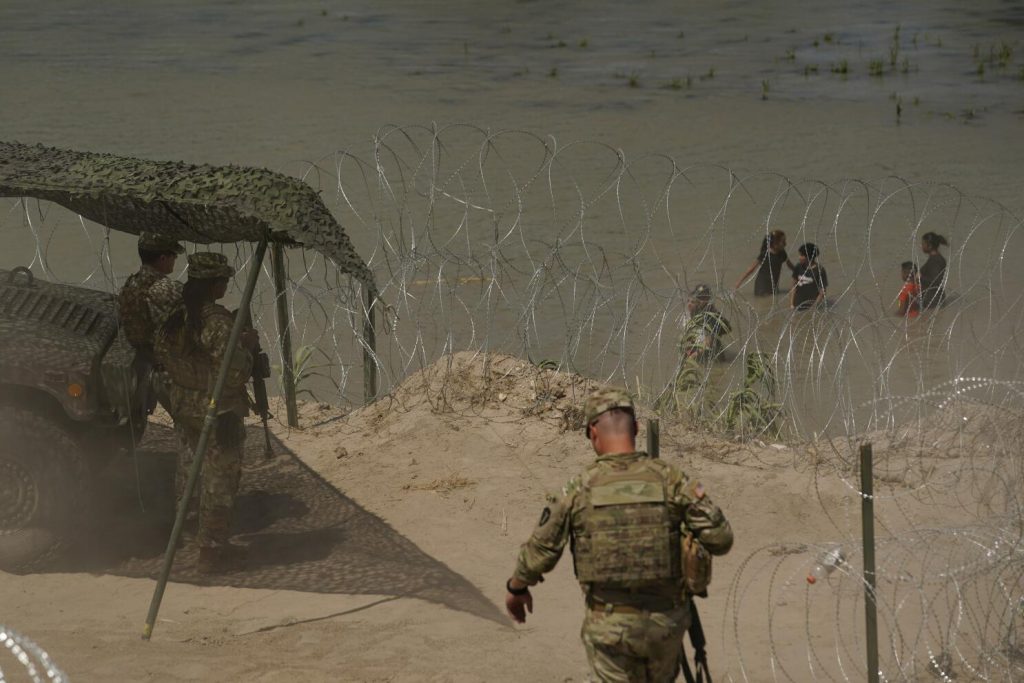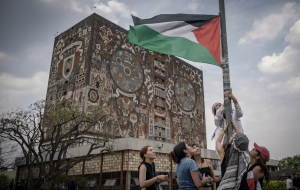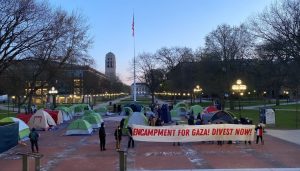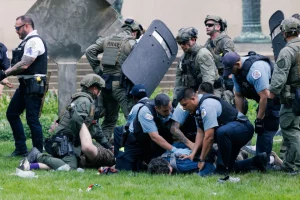Heading into the 2024 presidential election, immigration and the U.S.-Mexico border are once again at the center of national politics. While Republican presidential hopefuls work to outdo one another on aggressive immigration and border policies and claim that the Biden administration has been lenient, President Biden has continued Trump-era policies, from family separation to building a wall.
Todd Miller has covered the militarization and expansion of U.S. border policy for more than 15 years. He is a co-founder of the independent news site The Border Chronicle, and has authored four books on the subject.
Left Voice writer Samuel Karlin interviewed Todd Miller about bipartisan support for border militarization and how the border relates to U.S. foreign policy. The interview has been edited for clarity and length.
Many people had illusions that Biden would be a lesser evil on border militarization following the Trump years. Your reporting highlights how border militarization is bipartisan. How has this militarization developed across Democrat and Republican administrations?
Anyone who’s looked at the border over the years would probably look very skeptically at the idea that Biden would be the answer to the aggressive policies we saw under Trump. I certainly had tremendous skepticism with those sorts of claims. Looking at the history of border militarization, one of the foundational root moments of today’s border I would say is the implementation of the “prevention through deterrence” strategy that happened in the 1990s with operations like Operational Blockade, Hold the Line, Gatekeeper, and Safeguard. Those operations, lo and behold, came from the Bill Clinton administration, a Democrat administration. Every so often, I’ll dig up this 1995 State of the Union address, and what Bill Clinton says about immigration and the border then sounded very Trumpian. If you go to the budget during the 1990s, it goes from something like $1.5 billion to $4.5 billion for border and immigration enforcement. This is pre-Department of Homeland Security (DHS). At the time it was the biggest, most dramatic increase that we’ve ever seen, and that was during the Democratic administration.
Then there’s the post-9/11 administrations, starting with George W. Bush. After 9/11, we see the implementation of the DHS. All kinds of budgets went to the border and immigration enforcement during those years with bipartisan support. If you want to look at one example, go to the Secure Fence Act of 2006. Joe Biden voted yes to build what ended up being 650 miles of walls and barriers along the U.S.-Mexico border. And that carried on to the Obama administration. Did massive border budgets decrease with Obama? The answer’s no. In fact, the Obama model for immigration policy emphasized using Immigration and Customs Enforcement (ICE) to deport immigrants. His administration deported 3 million immigrants, more than every single president in the 20th century combined. There’s of course overt racism with Trump. He really took up the border wall and pushed xenophobia. It was interesting to watch the Democrats pivot from being fairly supportive of wall-building projects in the past, including the virtual wall, to claiming to work against the wall.
So by the time we get to the 2020 election, just given that history, there has to be a good dose of skepticism about Biden. I did a report with the Transnational Institute looking at the 2020 presidential campaigns. I looked at the Biden campaign versus the Trump campaign. We identified the top 10 border industry private companies. We found that those companies had given at a rate of three times more to Biden than to Trump. And then now, when you look at the contracts, which indicate private industry involvement in border policy, the number of contracts that we’ve been seeing in 2023 alone is higher than ever before. Under Biden, there’s a record number going to private industry for border surveillance and militarization.
So you have all these different policies across administrations that show how border militarization is bipartisan. If you look at the border industry, they give their campaign contributions to both sides of the aisle. Whoever’s president, they’re gonna make sure they’re delivering for the lobbyists that got them there. That explains this year’s $29.8 billion border enforcement budget, which is the highest ever for Customs and Border Protection (CBP) and ICE.
You mentioned the “virtual wall” which is important. Can you explain what this is and how it shows that, even before Biden started finishing Trump’s literal wall, his policies were still essentially expanding a border wall of surveillance technology?
First thing I should say is, when you talk to Border Patrol, if you go and meet with them in their offices, they will talk about not just the “border wall,” but what they call a “border wall system.” That system is not just the wall, the way it’s often portrayed in the media. From the DHS point of view, a wall on its own doesn’t do anything. So when they talk about a border wall system, that involves the walls and barriers, but those barriers are reinforced by two other things: surveillance technology and armed personnel, which we call the border patrol or the various police agencies that they work with.
This is such an important point, because when Biden was campaigning, he promised to not build one inch of wall. But even at the time he clarified that money would instead go to implementing more border surveillance technology, instead of putting that money towards anything humane like healthcare or education. And again, from the point of view of the agencies that enforce immigration like the CBP, the wall and the technology are the same thing.
Biden has been expanding technology which involves towers with cameras that can see 8.5 miles away. He’s expanding drone systems that the U.S. was using in Afghanistan, Iraq and other places that are now doing flights over the U.S.-Mexico border lands and also the Caribbean, Puerto Rico, and the northern border between North Dakota and Seattle. There’s biometric systems for facial recognition. They did a pilot program in southern Arizona, where they were taking people who live here, like myself, and whoever is traveling through a border patrol checkpoint would get their facial recognition captured, without any sort of consent, or any knowledge that it was being done. They’re trying to develop drones that are silent and can take people’s pictures without them knowing. This technology has become a huge element of the border wall system.
That’s what Biden means when he says he won’t build a wall, but will develop surveillance technology.
You’ve written about connections between U.S. foreign policy and border militarization and expansion, like border technology tested in the “War on Terror,” Israel’s exporting of surveillance tested on Palestinians, and the expansion of the border into Central America. Could you elaborate on these connections?
I’ll start with Palestine, given everything going on right now. I just did an interview with Jeff Halper, who’s a longtime resident of Jerusalem and a dual citizen of Israel in the United States. He’s done so much coverage of Israeli technology that’s been developed in the occupied territories. Israel has long been, per capita, the largest biggest developer of surveillance technology. One point Halper made is that every time there’s a military incursion into Gaza, like the one in overdrive now, they’re also testing out all this new equipment that they’ve been developing, like drone systems and that sort of thing. Through their interventions, the new technology gets a stamp of approval as tech that’s been “tested in combat,” and that makes it more lucrative.
You can go in so many different directions with these intersections, but when talking about the border and U.S. foreign policy, it makes sense to focus on Latin America. What has it been over the last centuries? The policy has been interventions, coups, military occupations, and dictatorships by generals and commanders trained in the United States in places like the School of the Americas. And all of this is to ensure that countries are friendly to U.S. companies. A great example of this is the role of the United Fruit Company and U.S. government in the 1954 coup which implemented a military dictatorship in Guatemala. This history of regime change and intervention as U.S. policy towards Latin America is very recent and we still see economic exploitation through neoliberal institutions like the International Monetary Fund. This all serves as the basis of U.S. policy towards Latin America now. The whole system is set up to allow big companies to come and go wherever they please — they have an open border policy — while people are surrounded by borders and militarized forces that are trained and armed by the United States.
We’ve talked about bipartisan support, but I want to focus on the role of far-right Republicans, especially leading up to the election. How seriously should we take this talk of drone strikes or sending special forces into Mexico? Also, how significant are some of the moves by Republicans like Texas governor Greg Abbott to enforce the border more through their state government instead of the federal government?
There’s always lots of more bark than bite. The talk of invading Mexico, I see that as pure bark at this point. The U.S. has invaded Mexico before, so it’s not like it’s never been done before. But right now, why would they do that? They have a very good relationship with Mexico. By good relationship, I mean, they’re in there training people. The U.S. is very much involved with the Mexican military apparatus, which includes the border and Mexico’s militarization of it.
I think the Republicans are just fanning the flames. Their strategy relies on their ability to just just throw things out there and not give a shit if it’s true or not. And it’s usually not. Trump was great at this. And because U.S. media is terrible — and they really are terrible — whatever anyone says gets quoted. The reporters don’t go and verify what they’re saying. That’s why we hear so many of these claims that Biden supports “open borders.”
I would differentiate that a little bit with the Abbott stuff. With Abbott, I was expecting the usual “more bark than bite.” But I’ve seen a lot of bite. All you have to do is go to El Paso and look at the boundary line with Ciudad Juarez. You’ll see the Texas National Guard, side by side with their armored jeeps in their full military regalia, hard helmets, and guns. Then, on the other side of the border, you’ll have some groups or families even that will come down on the embankment just to kind of find a place to knock on the door and ask for asylum. It’s a bizarre juxtaposition, seeing the military on one side and these families on the other. So I see the operation Lone Star stuff as different.
We’re precisely one year from the presidential elections. If the past is any indication, we’ll get a lot more of the bark than bite, but it’ll be a lot of bark.











